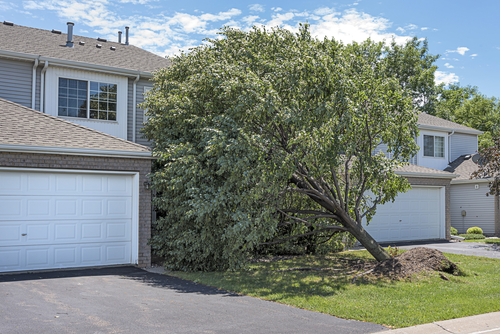Will Home Insurance Cover Costs of Fallen Tree Damage?
Every year, thousands of homes are damaged by fallen trees and limbs. Tornadoes or high winds are some of the many culprits that can cause fallen tree damage and add up major costs for homeowners. But no matter the cause, you’re likely to be covered by your homeowner’s insurance policy if a tree or a tree limb falls onto your home or damages your property. In fact, your home insurance policy covers you whether the tree in question sits on your property or your neighbor’s property in most cases.
“The coverage is really quite straightforward,” says Jeanne Salvatore, senior vice president at the Insurance Information Institute. “If a tree hits a home or other insured structure, such as a detached garage, standard homeowner’s insurance policies provide coverage for the damage the tree does to the structure and the contents in it.”
The Insurance Information Institute says that if your property is damaged by a tree, you should file an insurance claim — no matter who owns the tree.
By and large, homeowner’s insurance will limit coverage to roughly $500 for any single tree that’s toppled; this money is supposed to pay for replacement of the tree. If a tree hits your home or car, your insurer will cover the expense of removing the tree; this can cost about $500 to $1,000. Homeowner’s insurance also will cover damage done to your home by a fallen tree.
Damage to your vehicle from a fallen tree is covered by your auto insurance, not your home insurance.
If it’s a neighbor’s tree that hits your home, you still should call your own insurance company, says Chris Barneycastle, an arborist in Snellville, Ga., who’s frequently asked by insurers to assess tree damage. In most cases, your insurer will contact the neighbor’s insurance company, which will pay for the damage to your property. But in some cases, your insurer may pay your claim.
Homeowners insurance does in fact cover the costs of removing a tree that has fallen on your property if it was done by “perils” such as wind, tornado, etc. They usually will pay up to $550 on average to remove the tree or other foliage causing damage. You will want to check your specific home policy verbiage to make sure it is covered. Depending on your agreed upon policy you can expect them to pay between $550 to $1,000 per tree.

Keep in mind that tornadoes aren’t the only threat when it comes to tree damage. Other potential causes of damage are:
• Fire.
• Lightning.
• Explosion.
• Aircraft.
• Vandalism.
Whatever sort of tree disaster strikes, your home insurance company should be one of the first calls you make. “Trees are a part of your property, and they are insured,” Barneycastle says. “The insurer will come in and assess the situation, and cover the cost of having the tree removed.”
How to Avoid Home Damage from Fallen Trees
Homeowners don’t have to sit idly by and accept the fact that a storm can knock a tree down and send it falling through their living room windows. There are some steps property owners can take to minimize potential damage.
Barneycastle says it’s a good idea to let your neighbor know if he or she has any dead or otherwise potentially dangerous trees near your property.
“Put the neighbor on notice that their tree is hazardous,” he says. “If the tree damages your home, and you can prove that you had given your neighbor fair notice, his or her insurance company will definitely have to pay for the damage.”
One common-sense move that few homeowners seem to make is to closely examine the trees around their houses.
“The best thing is to occasionally wander around your yard and look up and observe what’s going on up there,” Reeves says. “Lots of folks look down horizontally, but few take the time to examine their tree canopies.”
If you notice any potential threats from trees near your home, Reeves advises hiring a tree professional to handle the problem.
“You can hire a certified arborist to do it every couple of years,” Reeves says. “An arborist can see things a homeowner might miss and can make recommendations about tree health and corrective actions.”
How to Remove a Fallen Tree
Make sure you have a written agreement with the tree removal service you’ve hired to clear damaged trees from your property, Barneycastle says. “The contract should specify details of cleanup and disposal of the wood and limbs that are cut up,” he says.
Walter Reeves, a gardening expert who hosts “Your Southern Garden” on Georgia Public Television, cautions homeowners against settling for the first tree care professional they find on the Internet.
“After hurricanes, tornadoes and ice storms, tree care professionals do an excellent job clearing downed trees and repairing damage,” Reeves says. “On the other hand, some ‘tree experts’ are experts only at taking money and chopping a tree into pieces.”
So how does a homeowner determine who can be trusted with the trees on his property? Reeves suggests contacting an organization that certifies or accredits tree specialists. One such group is the International Society of Arboriculture.
